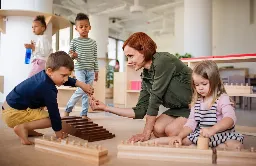Latest Blog & News

How to Earn Your 90-Hour Child Care Certification
02/17/2025As research continues to highlight the critical impact of #early experiences on a child's cognitive, social, and emotional #development, the demand for qualified childcare providers has surged. This growing need underscores the necessity for aspiring #educators to obtain relevant certifications that... How to Earn Your 90-Hour Child Care Certification

Leading the Way: How to Become a Childcare Director in Maryland
02/19/2025Leading the Way: How to Become a Childcare Director in Maryland Becoming a childcare director in Maryland is an exciting and rewarding #career path for those passionate about #early-childhood education. As a childcare director, you will #play a critical role in shaping the lives of young children... Leading the Way: How to Become a Childcare Director in Maryland

Your Path to Becoming a Childcare Director in Georgia
02/17/2025Becoming a childcare center director in Georgia is an exciting and rewarding #career path for those passionate about #early-childhood education. As a director, you will be responsible for overseeing daily operations, ensuring compliance with state regulations, and fostering a positive learning environment for both children and #staff. If you’re thinking about taking on this #leadership role, it’s essential to understand the qualifications and steps required. Meet the Minimum Education Requirements To become a childcare center director in Georgia, you must have at least a bachelor’s degree. Ideally, this degree should be in #early-childhood-education, child #development, or a related field. However, Georgia’s Department of Early Care and Learning (DECAL) allows other related degrees and experience to be considered as part of the qualification process. Gain Experience in Early Childhood Education In addition to educational requirements, Georgia childcare directors must also have practical experience in the field. Typically, you’ll need at least three years of experience working in a licensed childcare center, with at least one of those years in a leadership role. This experience will help you understand the daily challenges and responsibilities you’ll face as a director. Complete Required Training and Certification Georgia childcare providers must complete specific training to be eligible for a director position. These courses cover a wide range of topics, including child #safety, #health-and-nutrition, leadership skills, and state regulations. For example, to help you get started on your journey, we offer an excellent Childcare Director Training that covers essential leadership and operational skills needed in early childhood education settings. Understand State Regulations As a childcare center director, you will need to be well-versed in Georgia’s licensing requirements and regulations. These regulations cover everything from staff-child ratios to #health-and-safety standards, and you will be responsible for ensuring that your facility meets or exceeds them. Keeping up with ongoing training in these areas is essential for maintaining compliance and providing a #safe-environment for children. Apply for the Director Credential Once you’ve completed the necessary education and gained experience, you will need to apply for the Georgia Director’s Credential through the ChildCareEd. This credential demonstrates your qualifications to lead a childcare facility and is a critical part of the licensing process. You can learn more about the Georgia Director’s Credential on the Georgia Professional Development System website. Develop Key Leadership Skills In addition to meeting educational and experience requirements, becoming a successful director involves developing essential leadership skills. You will be managing staff, handling budgets, communicating with #parents, and overseeing the daily operations of your facility. Strong organizational, communication, and problem-solving skills are essential for the role. If you’re interested in developing these skills, we recommend checking out our Leadership and Management Training to improve your ability to manage a childcare facility effectively. Stay Current with Professional Development Childcare regulations and best practices are constantly evolving, so it’s crucial to engage in ongoing professional development. Attend workshops, #conferences, and training sessions to stay updated on industry changes and enhance your skills. ChildCareEd, offers continuing education credits that can help you maintain your director credentials. We offer a variety of resources and articles for childcare providers looking to continue their education. Our resource page offers valuable tools for directors and other early childhood professionals to stay informed and continue growing in their #careers. Explore Other Helpful Resources For further guidance on becoming a childcare center director and staying on top of industry standards, be sure to check out our article on Career Advancement in Early Childhood Education. This article offers insights into different career paths, including becoming a director, and provides useful tips for professional #growth. Stay Connected for More Tips and Updates As you work toward becoming a childcare director, staying connected with the latest resources and industry updates is essential. Be sure to follow us on our social media platforms for ongoing tips, training updates, and community-building opportunities. Follow us on Instagram to stay informed and get the latest updates! Becoming a childcare center director in Georgia requires a combination of education, experience, training, and leadership skills. By following these steps and continuously pursuing professional development, you can set yourself up for success in this rewarding and impactful role. Your Path to Becoming a Childcare Director in Georgia

Save $135 with Expiring Coupons – Don’t Miss Out on These Savings!
02/17/2025Attention all educators and caregivers! If you're looking to enhance your skills while saving money, you're in luck! A total of $135 in valuable coupons is about to expire in just 30 days. Whether you're seeking to improve your teaching methods or learn vital life-saving skills, these offers are too good to pass up. Let’s dive into the details of these amazing opportunities! 1. $10 Instructor Led Training! – Save $15 Transform your teaching approach with this incredible offer! This coupon allows you to access a range of courses designed to empower educators. From Tantrums to Triumphs: Equip preschoolers with self-regulation skills to create a positive learning environment. Play, Learn, Grow: Understand early childhood development to tailor your teaching to each child's needs. One World, Many Cultures!: Learn how to support children’s growth through a culturally sensitive lens. Don't let this chance to enrich your teaching skills slip away! 2. ❤️ Your Heart + CPR Skills = Lives Saved ($20 Off!) As a caregiver, your ability to respond in emergencies can make a world of difference. This coupon offers you $20 off essential CPR and First Aid training. Pediatric Blended First Aid & CPR/AED: Gain life-saving skills through engaging online learning and hands-on practice. Pediatric In-Person First Aid & CPR/AED: Participate in an in-person class to further hone your skills. Basic Life Support (BLS) Blended Healthcare Providers: Essential training for healthcare professionals needing BLS certification. Empower yourself with the knowledge to save lives—enroll today! 3. Lead with Learning – Save $100! Take a significant step in your career with a whopping $100 off on courses that will elevate your qualifications in early childhood education. CDA Family Child Care Credential with Portfolio Review: Complete 120 hours of training to earn your Family Child Care CDA credential. CDA Home Visitor Credential Birth to 5: Equip yourself with skills to empower families through home visits. CDA Infant/Toddler Credential with Portfolio Review: Focus on nurturing our littlest learners through specialized training. CDA Preschool Credential with Portfolio Review: Get ready to make a lasting impact on preschoolers' education. This is a fantastic opportunity to advance your career in early childhood education, so don’t wait! These coupons are set to expire soon, so make sure to take advantage of these savings while you can. Whether you're looking to enhance your skills, save lives, or advance your career, there's something here for everyone. Click on the links provided to grab your coupons before they're gone! Happy learning and saving! Save $135 with Expiring Coupons – Don’t Miss Out on These Savings!

Easy Ways to Get Your ECE Units Online!
02/11/2025In today's fast-paced world, the importance of #early-childhood-education (ECE) cannot be overstated. As the first #educators in a child's life, #early-childhood professionals play a crucial role in shaping their #development and learning experiences. However, many educators face significant challen... Easy Ways to Get Your ECE Units Online!

Why Every Childcare Worker Needs This CPR & First Aid Training
02/13/2025In today's world, the #safety and well-being of children are paramount concerns for parents, #educators, and caregivers alike. Childcare workers play a crucial role in this ecosystem, serving as the first line of defense in ensuring that children are not only nurtured and educated but also protected... Why Every Childcare Worker Needs This CPR & First Aid Training

This 40-Hour Training Is Your Fast Track to Childcare Success!
02/13/2025Childcare center directors play a pivotal role in shaping the educational experiences of young children, ensuring that they receive not only care but also a solid foundation for their future learning. However, the responsibilities that come with this role are multifaceted, encompassing everything fr... This 40-Hour Training Is Your Fast Track to Childcare Success!

The Shocking Truth About Medication in Childcare
02/13/2025In today's world, the role of childcare providers extends far beyond basic supervision and care. As the prevalence of chronic health conditions among children increases, the responsibility of administering medication #safely and effectively has become a critical aspect of childcare. This task is not... The Shocking Truth About Medication in Childcare

The Right Time to Get Your Child Development Associate Certification is NOW!
02/11/2025As research continues to highlight the critical role that the early years play in a child's #development, the demand for qualified professionals in this field is surging. Parents and communities are increasingly seeking high-quality childcare options, which places a premium on skilled #educators who... The Right Time to Get Your Child Development Associate Certification is NOW!

Georgia Childcare Providers: This Certification Could Change Your Career Forever!
02/11/2025In Georgia, the demand for skilled and knowledgeable childcare professionals is growing, driven by an increasing recognition of the critical impact #earlychildhood-education has on lifelong learning and success. However, with this demand comes the necessity for ongoing professional development to en... Georgia Childcare Providers: This Certification Could Change Your Career Forever!